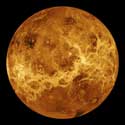To Venus with Love
 Full size image
Full size image
On 9th November the European Space Agency will launch Europe's first mission to Earth's closest planetary neighbour. The spacecraft, called Venus Express, is scheduled to launch from Baikonur Cosmodrome in Kazakhstan to visit Venus - the ultimate "greenhouse" planet. This is the first European mission to the planet which is seen as the brightest object in our night sky apart from the Moon.
Earth and Venus have often been thought of as twins as they share the same age, mass and diameter. However they are worlds apart in other respects. Named after the goddess of love and beauty, Venus has a very different climate to Earth's with a thick corrosive atmosphere giving rise to a run away greenhouse effect, crushing pressure and extremely hot surface temperatures twice as hot as an oven. But why has it evolved this way? Venus Express will provide the answer.
A team of scientists and engineers from the Mullard Space Science Laboratory (MSSL) in Holmbury St. Mary has built part of the ASPERA-4 instrument carried onboard which will study how the planet's atmosphere is effected by emissions from the Sun.
Unlike the Earth, Venus has no magnetic field and so the solar wind interacts directly with the ionosphere - the upper most section of the atmosphere. Over time this is eroded away and lost to space and it is a puzzle that Venus somehow manages to keep such a dense atmosphere.
Dr. Andrew Coates of MSSL said, "Venus is a difficult planet to explore due to the extreme surface conditions and very thick clouds. Venus Express will allow us to peer through the clouds and see in action the processes which keep the atmosphere so thick."
The atmospheric pressure on Venus is almost one hundred times that on Earth and the conditions are so hostile that that if humans were ever able to walk on the planet they would be simultaneously crushed, fried, sandblasted and maybe eaten by acid! ASPERA-4 will study the gas escaping the atmosphere of Venus in detail for the first time and other instruments onboard will help understand what is replenishing the atmosphere. One possibility is that there are active volcanoes on the planet.
A large team of people at MSSL have been involved in Venus Express through their work in the ASPERA-4 instrument. The people and their involvement are:
Andrew Coates - Co-Investigator
Dhiren Kataria - Detector scientist & Project Manager
Dave Linder - Resource Manager
Louisa Bradley and Paul Addison - Calibration support
John Coker - Mechanical design
Berend Winter - Thermal design
Barry Hancock and Mark Hailey - Electronics support
Sharon Williams - Data analysis
Ros Medland - Administrative support
Tony Murrell - Mechanical design
John Raymont - Calibration Support
Venus Express will take 5 months to arrive at Earth's 'evil twin' where it
promises to return some spectacular results.
![]() +44 (0)1483 204100 - Copyright © 1999-2005 UCL
+44 (0)1483 204100 - Copyright © 1999-2005 UCL